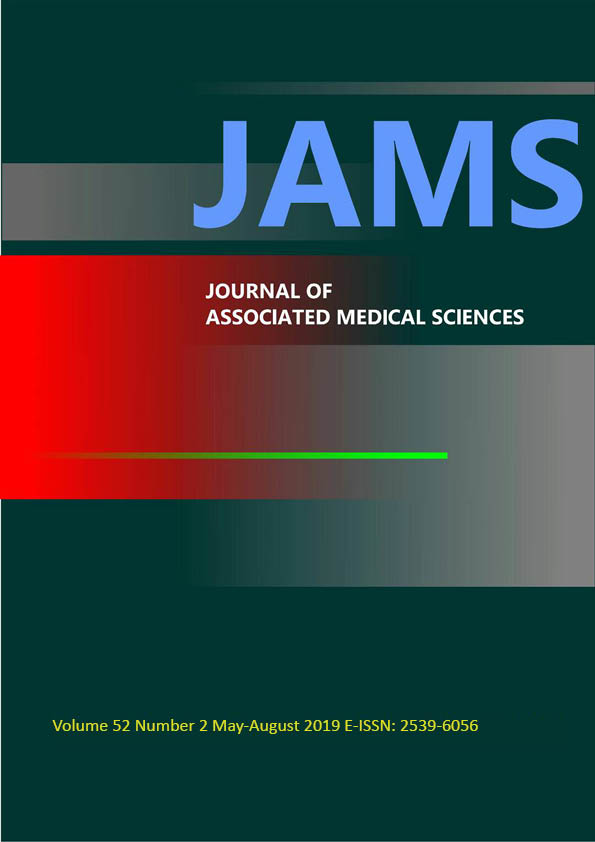Test-retest Reliability of the Five Times Sit-to-Stand Test measured using the kinect in older adults
Main Article Content
Abstract
Background: The Kinect camera system is a low-cost portable device that can be used to time the Five Times Sit-to-Stand Test (FTSST). However, there is insufficient information and limited studies concerning the reliability of the Kinect measurements when compared with standard clinical stopwatch measurements.
Objectives: The aims of this study were to investigate the test-retest reliability of the FTSST as measured using a Kinect camera and to determine its agreement with standard clinical stopwatch measurements.
Materials and methods: Thirty older adults were timed while performing four repeated FTSSTs under two conditions: with and without their arms crossed. There were 10-minute breaks between the four tests. The times were simultaneously recorded by a Kinect camera system and by a research assistant using a stopwatch.
Results: The intraclass correlation coefficient (ICC) values for the test-retest reliability were 0.664 with the arms crossed and 0.843 with the arms free. In addition, the determination of the agreement between the Kinect and the stopwatch measurements in this study produced ICC values of 0.944 with the arms crossed and 0.954 with the arms free.
Conclusion: The test-retest reliability of the FTSST as measured using the Kinect system was good to excellent, and its agreement with the standard clinical stopwatch was excellent.
Article Details

This work is licensed under a Creative Commons Attribution-NonCommercial-NoDerivatives 4.0 International License.
Personal views expressed by the contributors in their articles are not necessarily those of the Journal of Associated Medical Sciences, Faculty of Associated Medical Sciences, Chiang Mai University.
References
[2] Janssen WG, Bussmann HB, Stam HJ. Determinants of the sit-to-stand movement: a review. Phys Ther. 2002; 82(9): 866-79.
[3] Bohannon RW. Daily sit-to-stands performed by adults: a systematic review. J Phys Ther Sci. 2015; 27(3): 939-42. doi: 10.1589/jpts.27.939.
[4] Thaweewannakij T, Suwannarat P, Mato L, Amatachaya S. Functional ability and health status of communitydwelling late age elderly people with and without a history of falls. Hong Kong Physiotherapy Journal. 2016; 34: 1-9. doi: 10.1016/j.hkpj.2015.08.001.
[5] Silva PF, Quintino LF, Franco J, Faria CD. Measurement properties and feasibility of clinical tests to assess sit-to-stand/stand-to-sit tasks in subjects with neurological disease: a systematic review. Braz J Phys Ther. 2014; 18(2): 99-110.
[6] Bohannon RW, Bubela DJ, Magasi SR, Wang YC, Gershon RC. Sit-to-stand test: Performance and determinants across the age-span. Isokinet Exerc Sci. 2010; 18(4): 235-40. doi: 10.3233/IES-2010-0389
[7] Goldberg A, Chavis M, Watkins J, Wilson T. The five-times-sit-to-stand test: validity, reliability and detectable change in older females. Aging Clin Exp Res. 2012; 24(4): 339-44.
[8] Lusardi MM, Fritz S, Middleton A, Allison L, Wingood M, Phillips E, et al. Determining risk of falls in community dwelling older adults: a systematic review and meta-analysis using posttest probability. J Geriatr
Phys Ther. 2017; 40(1): 1-36. doi: 10.1519/JPT.0000000000000099.
[9] Ng SS, Cheung SY, Lai LS, Liu AS, Ieong SH, Fong SS. Association of seat height and arm position on the five times sit-to-stand test times of stroke survivors. Biomed Res Int. 2013; 2013: 642362. doi: 10.1155/2013/642362.
[10] Lord SR, Murray SM, Chapman K, Munro B, Tiedemann A. Sit-to-stand performance depends on sensation, speed, balance, and psychological status in addition to strength in older people. J Gerontol A Biol Sci Med Sci. 2002; 57(8): M539-43. doi: 10.1093/gerona/57.8.m539.
[11] Chan MHM, Keung DTF, Lui SYT, Cheung RTH. A validation study of a smartphone application for functional mobility assessment of the elderly. Hong Kong Physiother J. 2016; 35: 1-4. doi: 10.1016/j.hkpj.2015.11.001.
[12] Regterschot GR, Zhang W, Baldus H, Stevens M, Zijlstra W. Accuracy and concurrent validity of a sensor-based analysis of sit-to-stand movements in older adults. Gait Posture. 2016; 45: 198-203. doi: 10.1016/j.gaitpost.2016.02.004.
[13] Vernon S, Paterson K, Bower K, McGinley J, Miller K, Pua YH, et al. Quantifying individual components of the timed up and go using the kinect in people living with stroke. Neurorehabil Neural Repair. 2015; 29(1): 48-53. doi: 10.1177/1545968314529475.
[14] Ejupi A, Brodie M, Gschwind YJ, Lord SR, Zagler WL, Delbaere K. Kinect-based five-times-sit-to-stand test for clinical and in-home assessment of fall risk in older people. Gerontology. 2015; 62(1): 118-24. doi: 10.1159/000381804.
[15] Mokkink LB, Prinsen CA, Bouter LM, Vet HC, Terwee CB. The COnsensus-based Standards for the selection of health Measurement INstruments (COSMIN) and how to select an outcome measurement instrument. Braz J Phys Ther. 2016; 20(2): 105-13. doi: 10.1590/bjpt-rbf.2014.0143.
[16] Weir JP. Quantifying test-retest reliability using the intraclass correlation coefficient and the SEM. J Strength Cond Res. 2005; 19(1): 231-40. doi: 10.1519/15184.1.
[17] Galna B, Barry G, Jackson D, Mhiripiri D, Olivier P, Rochester L. Accuracy of the Microsoft Kinect sensor for measuring movement in people with Parkinson's disease. Gait Posture. 2014; 39(4): 1062-8. doi: 10.1016/j.gaitpost.2014.01.008.
[18] Kim MJ, Yabushita N, Kim MK, Nemoto M, Seino S, Tanaka K. Mobility performance tests for discriminating high risk of frailty in community-dwelling older women. Arch Gerontol Geriatr. 2010; 51(2): 192-8. doi: 10.1016/j.archger.2009.10.007.
[19] Cicchetti DV. Guidelines, criteria, and rules of thumb for evaluating normed and standardized assessment instruments in psychology. Psychol Assess. 1994; 6(4): 284-90.
[20] Bruton A, Conway JH, Holgate ST. Reliability: What is it and how is it measured? Physiotherapy. 2000; 86(2): 94-9.
[21] Bohannon RW. Test-retest reliability of the five-repetition sit-to-stand test: a systematic review of the literature involving adults. J Strength Cond Res. 2011; 25(11): 3205-7. doi: 10.1519/JSC.0b013e318234e59f.
[22] Ng SS, Cheung SY, Lai LS, Liu AS, Ieong SH, Fong SS. Five Times Sit-To-Stand test completion times among older women: Influence of seat height and arm position. J Rehabil Med. 2015; 47(3): 262-6. doi: 10.2340/16501977-1915.


